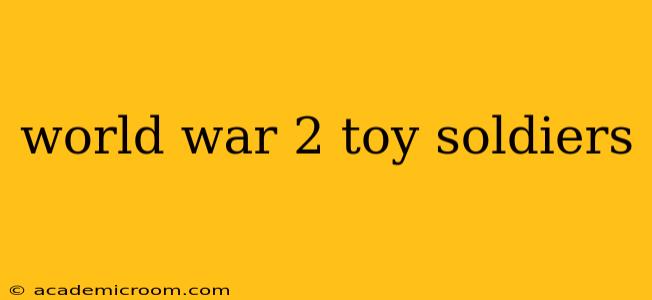World War II cast a long shadow, influencing art, culture, and even the toys children played with. Toy soldiers, particularly those depicting WWII battles, became incredibly popular, reflecting both the global conflict's impact and the enduring fascination with military history. This article delves into the history of WWII toy soldiers, exploring their evolution, materials, popular designs, and lasting legacy.
What Materials Were World War 2 Toy Soldiers Made Of?
The materials used to create WWII toy soldiers varied considerably depending on factors like manufacturing location, cost, and availability of resources during wartime. Early examples often utilized lead, offering durability and the ability to maintain intricate detail. However, concerns over lead poisoning led to a shift towards other materials, including tin, plastic, and hollow cast metal. Tin soldiers were lightweight yet robust, while plastic, increasingly prevalent post-war, allowed for mass production and greater affordability. The choice of material often impacted the price and longevity of the toy. Some high-end models retained the use of lead well into the postwar era, though these were often more expensive collector's items.
Where Were World War 2 Toy Soldiers Made?
WWII toy soldiers were manufactured across the globe, with significant production in Germany, Britain, the United States, and Japan. Each country's production reflected its own cultural influences and manufacturing capabilities. German manufacturers, for instance, were known for their detailed and realistic designs, often reflecting the military precision of the era. British manufacturers produced a wide range of styles, while American production leaned towards mass-produced, more affordable toys. Japanese manufacturers, while initially limited due to wartime restrictions, later played a significant role in the post-war toy soldier market.
What Were Some Popular World War 2 Toy Soldier Designs?
The designs varied widely, reflecting the diverse theaters of war and the iconic imagery associated with the conflict. Popular designs often featured:
- Infantry soldiers: Representing the foot soldiers who formed the backbone of armies.
- Tanks and armored vehicles: Iconic vehicles like the Sherman tank or the Tiger tank, were frequently depicted.
- Aircraft: From Spitfires to Messerschmitts, miniature airplanes added another dimension to play.
- Artillery pieces: Canons and howitzers provided a static element to the battlefield recreations.
- Specific battles: Certain significant battles, like D-Day or the Battle of the Bulge, inspired entire sets.
Many sets included accessories, enhancing the play experience: miniature trees, fences, and even small figures representing civilians.
How Did World War 2 Toy Soldiers Reflect the War?
The toy soldiers themselves often reflected the prevailing ideologies and propaganda of the time. Allied soldiers were often depicted as heroic and courageous, while Axis soldiers might have been portrayed in a more stereotypical manner. However, this varied widely depending on the manufacturer and the target market. The toys, therefore, weren't simply playthings but also a reflection of cultural perceptions surrounding the war.
What Is The Value of World War 2 Toy Soldiers Today?
The value of WWII toy soldiers today is highly dependent on factors such as:
- Rarity: Certain brands or specific designs are rarer than others.
- Condition: Well-preserved, complete sets command higher prices.
- Material: Lead soldiers, due to their early production and often higher detail, can be especially valuable.
- Manufacturer: Some manufacturers have a greater reputation for quality and detail, impacting value.
While some are simply nostalgic childhood toys, others can be significant collector's items, fetching substantial prices at auctions and antique shops.
Were World War 2 Toy Soldiers Educational?
Whether WWII toy soldiers are educational is a complex question. On one hand, they can inspire an interest in military history, encouraging children to learn about specific battles, weapons, and uniforms. On the other hand, the simplistic nature of many designs may not accurately reflect the complexities of the conflict. It's crucial to supplement play with further educational resources to provide a well-rounded understanding of the war's impact and human cost. The toys can be a springboard for learning, but not a replacement for more comprehensive study.
Are World War 2 Toy Soldiers Still Made Today?
Yes, many companies continue to produce WWII toy soldiers today, often using modern materials and techniques while still maintaining the style and charm of their predecessors. These range from mass-produced inexpensive toys to highly detailed, hand-painted models for collectors. The enduring appeal of this genre ensures that future generations will also have the opportunity to recreate the battles and experience the history, however miniature, of World War II.
This article provides a comprehensive overview of WWII toy soldiers, touching upon their materials, origins, designs, and value. It aims to provide a nuanced understanding of these miniature artifacts, highlighting their historical context and ongoing relevance in the world of collectible toys and historical representation.
